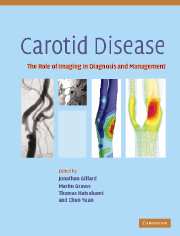Book contents
- Frontmatter
- Contents
- List of contributors
- List of abbreviations
- Introduction
- Background
- 1 Pathology of carotid artery atherosclerotic disease
- 2 Epidemiology of carotid artery atherosclerosis
- 3 Genetics of carotid atherosclerosis
- 4 Hematological processes in emboli formation
- 5 Medical treatment for carotid stenosis
- 6 Surgical management of symptomatic carotid disease: carotid endarterectomy and extracranial-intracranial bypass
- 7 Surgery for asymptomatic carotid stenosis
- 8 Interventional management of carotid disease
- Luminal imaging techniques
- Morphological plaque imaging
- Functional plaque imaging
- Plaque modelling
- Monitoring the local and distal effects of carotid interventions
- Monitoring pharmaceutical interventions
- Future directions in carotid plaque imaging
- Index
- References
7 - Surgery for asymptomatic carotid stenosis
from Background
Published online by Cambridge University Press: 03 December 2009
- Frontmatter
- Contents
- List of contributors
- List of abbreviations
- Introduction
- Background
- 1 Pathology of carotid artery atherosclerotic disease
- 2 Epidemiology of carotid artery atherosclerosis
- 3 Genetics of carotid atherosclerosis
- 4 Hematological processes in emboli formation
- 5 Medical treatment for carotid stenosis
- 6 Surgical management of symptomatic carotid disease: carotid endarterectomy and extracranial-intracranial bypass
- 7 Surgery for asymptomatic carotid stenosis
- 8 Interventional management of carotid disease
- Luminal imaging techniques
- Morphological plaque imaging
- Functional plaque imaging
- Plaque modelling
- Monitoring the local and distal effects of carotid interventions
- Monitoring pharmaceutical interventions
- Future directions in carotid plaque imaging
- Index
- References
Summary
Introduction
Stroke is the third most common cause of death and a leading cause of disability in the Western world. In England and Wales, over 130 000 people will suffer a stroke annually. Of those who suffer from a stroke, a third are likely to die within the first 10 days, a third are likely to make a recovery within 1 month and a third are likely to be left disabled and need rehabilitation. Disability in those of working age prevents 80% of stroke survivors from continuing their normal job (Teasell et al., 2000). In the United Kingdom, stroke affects over a quarter of a million people and is at present costing over £7 billion a year. Prevention of 10–15% of these strokes by judicial use of carotid surgery would benefit patients and the economy.
In the United States stroke mortality has fallen by 15% over 10 years (1988–98) (American Heart Association, 2000). Although the US Framingham study found that stroke severity and mortality decreased, stroke incidence and prevalence rates increased during the same time period (Wolf et al., 1992). The British Government has set a target of reducing stroke incidence by 40% but as the percentage of the population over 65 years increases, the absolute number of stroke victims is likely to rise substantially by 2010 (Sacco et al., 1997).
Improvement in stroke mortality may be due to control of hypertension, hypercholesterolemia and a decline in cigarette smoking.
Keywords
- Type
- Chapter
- Information
- Carotid DiseaseThe Role of Imaging in Diagnosis and Management, pp. 86 - 93Publisher: Cambridge University PressPrint publication year: 2006



